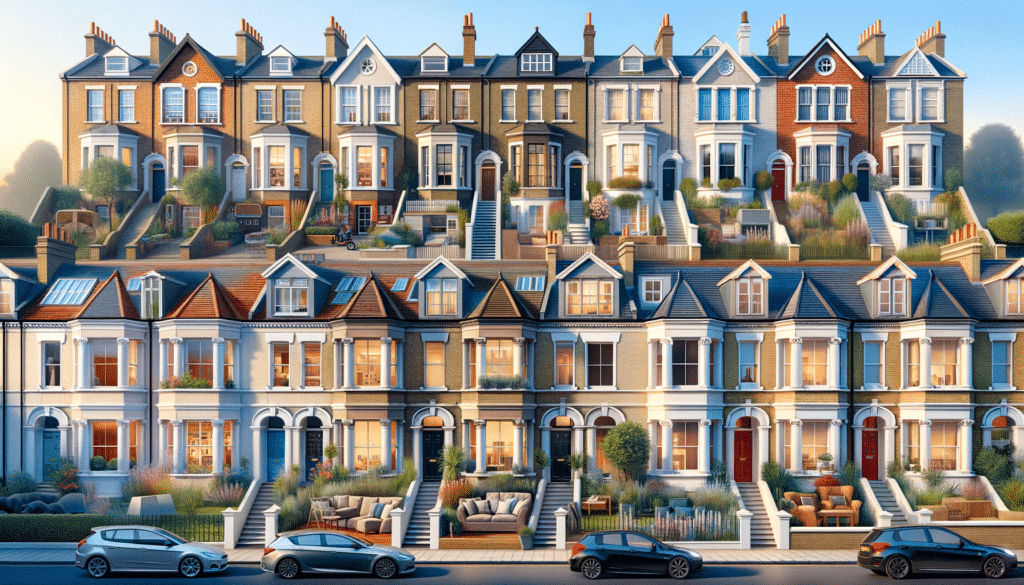The Historical Evolution of London Homes
London, a city steeped in history, has seen its architectural landscape evolve over centuries. The homes in London are a testament to its rich past, reflecting various architectural styles that have emerged over time. From the Georgian terraces that line the streets of areas like Bloomsbury to the Victorian and Edwardian houses that dominate the suburbs, each era has left its mark. These homes are not just places of residence; they are historical artifacts that tell the story of London’s development.
The Georgian period, spanning from 1714 to 1830, introduced the iconic terraced houses characterized by their symmetrical façades and sash windows. These homes were designed to maximize space in the burgeoning city and often featured elegant interiors with high ceilings and ornate moldings. As London expanded, the Victorian era brought about more ornate designs, with homes featuring bay windows, decorative brickwork, and intricate ironwork. The Edwardian period, although shorter, continued this trend with a focus on larger, more spacious homes that catered to the growing middle class.
Today, these historical homes are highly sought after, not only for their aesthetic appeal but also for their cultural significance. Living in a Georgian or Victorian home in London means owning a piece of history, a connection to the past that is cherished by many. However, maintaining these homes can be challenging, requiring careful restoration to preserve their original features while integrating modern amenities.
Modern Living in London: Contemporary Homes
As much as London is known for its historical architecture, it is also a hub for modern design and innovation. The city embraces contemporary architecture, with new developments constantly reshaping its skyline. Modern homes in London are characterized by their sleek lines, open-plan living spaces, and the use of sustainable materials. These homes often incorporate the latest technology, offering smart home features that enhance convenience and efficiency.
One of the notable trends in modern London homes is the emphasis on sustainability. Developers are increasingly incorporating eco-friendly materials and energy-efficient systems to reduce the environmental impact. This includes the use of solar panels, green roofs, and rainwater harvesting systems. Such features not only appeal to environmentally conscious buyers but also contribute to long-term cost savings.
Furthermore, contemporary homes in London often prioritize open spaces and natural light, creating a seamless connection between indoor and outdoor living. This design philosophy reflects the changing lifestyle preferences of residents who value flexibility and comfort. The integration of gardens, terraces, and balconies in urban homes offers a breath of fresh air in the bustling city environment.
The Role of Location in London’s Housing Market
The location of a home in London significantly influences its value and desirability. Central areas like Kensington, Chelsea, and Mayfair are renowned for their luxury properties, attracting affluent buyers from around the world. These neighborhoods offer proximity to London’s cultural landmarks, high-end shopping districts, and prestigious schools, making them highly coveted.
In contrast, areas like Hackney, Brixton, and Shoreditch are known for their vibrant, eclectic communities and more affordable housing options. These neighborhoods have become popular among young professionals and creatives, drawn by the lively atmosphere and diverse cultural scene. The regeneration of these areas has also led to a rise in property values, making them attractive investment opportunities.
Transport links are another crucial factor in the London housing market. Properties located near tube stations or major transport hubs often command higher prices due to the convenience they offer. The ongoing expansion of the London Underground and the development of new rail lines continue to impact property values, with areas benefiting from improved connectivity seeing increased demand.
Challenges and Opportunities in the London Housing Market
The London housing market presents both challenges and opportunities for buyers and investors. One of the primary challenges is the high cost of property, which can be prohibitive for many first-time buyers. The demand for housing in London often outstrips supply, leading to competitive bidding and rising prices. This has prompted the government to implement measures aimed at increasing housing supply and making homeownership more accessible.
Despite these challenges, there are opportunities for savvy investors. The diverse range of properties available, from historical homes to modern apartments, offers potential for capital growth and rental income. Additionally, London’s status as a global financial center ensures a steady influx of international buyers and tenants, further supporting the housing market.
For those looking to invest in London real estate, understanding market trends and conducting thorough research is essential. Engaging with local real estate agents and staying informed about upcoming developments can provide valuable insights into the market dynamics. By navigating these challenges and seizing opportunities, investors can find success in the dynamic London housing market.
The Future of London Homes: Innovations and Trends
Looking ahead, the future of London homes is shaped by innovation and emerging trends. As the city continues to grow, the need for sustainable urban living solutions becomes increasingly important. This includes the development of green buildings, smart homes, and mixed-use developments that integrate residential, commercial, and recreational spaces.
Technological advancements are also influencing the way homes are designed and built. The use of digital tools and artificial intelligence in architectural design is streamlining the construction process, allowing for more efficient and cost-effective building practices. These technologies are also enabling the creation of customizable living spaces that cater to individual preferences and lifestyles.
Moreover, the concept of co-living is gaining traction in London, particularly among young professionals and students. Co-living spaces offer a community-oriented living environment with shared amenities, promoting social interaction and collaboration. This trend reflects the changing attitudes towards homeownership and the desire for flexible, affordable living options in a dynamic urban setting.




